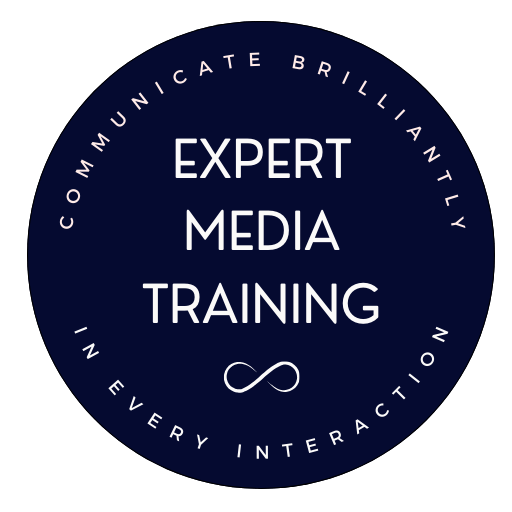Thursday, October 24, 2013 | Branding
Branding is a hot topic in business and in media training and presentation training.
 The brand has grown to extend far beyond its origins, when a brand was the insignia used primarily to mark cattle and products that craftspeople made.
The brand has grown to extend far beyond its origins, when a brand was the insignia used primarily to mark cattle and products that craftspeople made.
True branding extends far beyond logos and the colors and fonts and design elements you use on your website, social media pages and products, although these are very important. People respond to a good brand in a visceral, emotional way. When you receive media training, your trainer should help your personal brand to come through.
A focus on your brand in media interviews is a part of any good media training session.
The brand of your company or organization, and/or you as a person, should be clear and come across every time you give an interview or make a presentation.
Because evolved people don’t live by pictures alone, the “language of your brand” is just as important as the visual elements, and sometimes even more so. Yet, most people don’t give nearly as much thought to the language of their brand as they do the visual elements.
What is the language of your brand in media interviews?
Quite often, people will experience your brand solely through words. When people talk about you, your company, or your services or products, they will use words. A print interview that you give will rely solely on the words that you speak.
The words people choose to describe you will come partly from the experience they have had with you and partly from the very words you have said or written.
In your media training sessions and message development sessions, focusing on the language of your brand in interviews will give you a great sense of clarity before your interviews.
Any time you speak about yourself or your company, even in something as seemingly mundane as a quick phone call or a one-on-one meeting, you’re conveying your brand. Of course, when you speak from a stage or through social media or traditional media (e.g., TV, radio or print interviews), you’re transmitting your brand to masses of people simultaneously, but you can still do it in a way that feels personal.
The language of your brand goes far beyond having a good elevator pitch or introductory phrase that you and your team use when you meet people. It’s also much more than a list of descriptions that you or your staff read off of a page when explaining what you do.
What are the words, phrases and explanations that you and your entire team use to convey your brand in media interviews and in every interaction, from the way your phone is answered and problems are handled, to the way you interact with people at functions when you think no one is watching, to the way you interact with your staff or your team members?
What are the words or phrases you will use that will stick in people’s heads and reach their hearts?
Your brand in media interviews is conveyed in everything you do before, during, and after the interview.
Friday, October 18, 2013 | Communication, Media Training, Public Speaking
The use of acronyms and abbreviations seems to have increased significantly over the past decade, primarily due to the growth of texting and the shrinking of sentences to fit within Twitter’s character limits.
The use of acronyms and abbreviations in media interviews or speeches can often create confusion, turn people off and, possibly, make you appear less eloquent than you are.
The difference between acronyms and abbreviations:
An acronym is pronounced like a word and is generally comprised of the first letter of each word in a phrase. Example: SWOT (which stands for “strengths, weaknesses, opportunities, threats”).
An abbreviation consists of the first letter of each word in a phrase or name, but each letter is pronounced individually. Example: D.I.Y. (which stands for “do it yourself”).
Of course, the above acronym and abbreviation could each have other meanings, but these are among the most common meanings for them. This brings me to the first of my tips for using acronyms and abbreviations effectively in media interviews or speeches:
1. Avoid using acronyms or abbreviations that could easily be confused with more commonly known ones. For example, if my team and I referred to our company as “E.M.T.”, rather than Expert Media Training™, a large percentage of people would be confused because “E.M.T.” is commonly used to describe an “emergency medical technician”. The difference is vast: if there’s a speech emergency I can help you, but you probably don’t want me intubating you.
2. Avoid using abbreviations or acronyms that may not be known to the majority of your audience. If you are in a media interview or giving a speech that will last more than a few minutes, and you plan on using an abbreviation to refer to something with a long name, explain this the first time you mention the full name associated with the abbreviation. This should be practiced during your media training, so you become fluid with your delivery.
3. If you can create an acronym for a system you have created or something else you want people to remember, this can be very useful for marketing and for making you memorable. If you plan to use the acronym in a media interview or speech, explain what it means early on.
4. In broadcast interviews or speeches, don’t use abbreviations that contain more syllables than the words themselves. Example: using “G.W.P.” (5 syllables) instead of “gift with purchase” (4 syllables). You could probably get away with this in an article you author, but this kind of “marketing speak” rarely impresses people.
5. If, during an interview or speech, you use abbreviations that are replacements for slang expressions, like “LOL” or “OMG”, know that this will convey a certain image of you. If you use these facetiously, it will shape your image in a different way.
6. If you use too many acronyms or abbreviations throughout your interview or speech, people may think you spend too much time texting and not enough time working…unless you work in social media, perhaps.
7. Choose your acronyms and abbreviations as consciously as you would other words and phrases, and you should be fine. I was tempted to use a lot of acronyms here, but I didn’t want you to TIWAJ. (I’ll let your imagination work on what TIWAJ could mean.)
For more media training and presentation training tips provided by Media Trainer Lisa Elia, the founder of Expert Media Training™, visit https://expertmediatraining.com/blog

Monday, October 7, 2013 | Interview Skills, Media Interview Tips, Media Relations, Media Training, Media Training for Actors
One of the most interesting things I’ve had the pleasure of doing is to interview members of the media about what they seek in guests to interview and what they think potential guests and interviewees should do to get featured in large media outlets.
The video below is from an interview I conducted at my Meet the Media Day event, with Nicole Dorsey Straff, who had been on the launch team as managing editor of Fit Magazine, spent years as Fitness magazine’s west coast editor, and is now at ValueClick Brands. In this video, Nicole touches on what the media want, how to get featured in large media outlets, and more.
Watch the video below to learn what the media want and to learn how to get featured in large media outlets.
If you want to share what the media want with your friends, you can do so by using the share buttons below.
If you want additional tips on how to get featured in large media outlets and information about what the media want, read some of the other blog posts by Media Trainer Lisa Elia:
Top 10 Media Relations Tips – Media Training Tips from a Media Trainer
https://expertmediatraining.com/media-training-tips-for-good-media-relations/
Media Interview Checklist
https://expertmediatraining.com/media-interview-checklist-from-a-media-trainer/
How to Create an Online Press Room that the Media Will Love
https://expertmediatraining.com/online-press-room-tips-from-media-trainer/
Would you like more tips and articles delivered straight to your inbox?
Click here.

 This post was written by Lisa Elia, a media trainer, presentation trainer, pitch coach, communication expert, and speaker. She trains clients around the world for media interviews, speeches, internal and external presentations, panels, investor presentations, and promotional videos, and provides executive and team communication coaching.
This post was written by Lisa Elia, a media trainer, presentation trainer, pitch coach, communication expert, and speaker. She trains clients around the world for media interviews, speeches, internal and external presentations, panels, investor presentations, and promotional videos, and provides executive and team communication coaching.
With more than 25 years of experience, Lisa has prepared clients for interviews with TODAY, GMA, The Wall Street Journal, CNN, ESPN, and hundreds of other outlets. Lisa has shared her expertise with national media outlets that include Inc., Entertainment Tonight, E!, and many others. Clients include entrepreneurs, Fortune 500 companies, and everything in between as well as athletes, celebrities, and other public figures.
Monday, September 16, 2013 | Business Tips, Messaging
 “Present yourself as vital and ever evolving, and people will be magnetized to you.”
“Present yourself as vital and ever evolving, and people will be magnetized to you.”
When I wrote these words, I was in deep thought about the qualities and actions that attract people, in preparation for the free teleseminar that I held last year.
When people show that they are continuously evolving, they capture the attention of others. Businesses are the same because, after all, businesses are the creations of people.
Vital. Here’s why you want to be vital. These definitions came from Dictionary.com:
- “of or pertaining to life.
- having remarkable energy, liveliness, or force of personality.
- being the seat or source of life.
- necessary to life.
- necessary to the existence, continuance, or well-being of something; indispensable; essential.”
Who wouldn’t want even one of these descriptions to suit them?
Here’s some quick “thinkwork” you can do.
Think of at least one way that you — or your business, or your music or art or books — can be seen as “vital” to your customers, clients or fans.
Consider how you can continue to evolve and to let others know about it. People want to see what’s coming next. Entice them, lead them, excite them.
Thursday, September 5, 2013 | Communication
 We hear so much about authenticity and transparency and accountability. All of these are felt by others through our communication. What it really comes down to is maturity.
We hear so much about authenticity and transparency and accountability. All of these are felt by others through our communication. What it really comes down to is maturity.
Communicating with maturity is very simple.
Here are some tips on how to communicate with maturity:
It includes taking responsibility for one’s actions and for the promises one makes, and communicating clearly when you cannot deliver on your promises due to extenuating circumstances.
Communicating with maturity is communicating with thoughtfulness and the knowledge that there are consequences that come when certain words are spoken.
Communicating with maturity results in fewer disagreements and less drama in life.
Communicating with maturity requires strength, clarity, and self-knowledge, and it is the most freeing way to communicate.
For additional communication tips, check out my Confident and Clear Communication program.

Wednesday, April 24, 2013 | Media Relations, On-camera, Video
Wednesday, April 10, 2013 | Interview Skills, Media Training

I was on Entertainment Tonight recently, sharing my PR and media training expertise.
This was my fourth segment with ET, and the show producers had called me two other times when I wasn’t able to tape the segments due to scheduling conflicts. However, I believe that one of the reasons the producers have called me so much is that I’m easy to work with.
As a media trainer, I offer you these tips to prepare for TV interviews:
1. If you are positioning yourself as an expert, stay up on research, trends and news related to your field and think about how to articulate various aspects of your work so that you can easily answer questions about it. If you have not had media training yet, do not wait until the day before you have an interview. Get it as soon as you begin to think about putting yourself into the public eye so that you have time to work with your media trainer on creating clear responses to questions and on polishing your delivery.
2. Have your preparation ritual down, so that you can center yourself and get your energy up with very little notice. Quite often, you will receive requests for interviews that must take place within hours, or sometimes minutes. Having a good preparation ritual that you use to get in performance mode can give you the confidence to say “yes” to great opportunities, even when you are very busy.
Preparation rituals are included in all of our programs. When we have provided media training for actors or music artists, we have observed that they love our techniques, because they are based in acting training and movement training.
When we provide media training for athletes, they too appreciate the use of a quick preparation ritual, as most of them use them in their professional work.
3. Knowing that many media interviews come up very quickly (sometimes with less than 24 hours’ notice), have your wardrobe ready to go, have your hair cut and colored the way you want it, nails manicured, etc., at all times. This is the life of a public figure, which is what you become if you put yourself out into the public eye as an expert.
4. Try to accommodate last-minute media requests, if you can. If you say “no”, someone else will say “yes”.
Suze Orman skyrocketed into the public spotlight because she told the producers of The Oprah Winfrey Show that she could be an emergency guest. They asked her to fly in and sit in the front row so they could ask her a question: she answered it so much to Oprah’s liking that Oprah asked her back, and rest is history.
You can watch my interviews on Entertainment Tonight and learn more about the media interviews that have arisen for me as a media trainer and PR expert at https://expertmediatraining.com/press-room/.
To further prepare for TV interviews, use the quick list of items to have ready to go, which you can find on this blog post:
Here are some other links you may find useful in preparing for media interviews:
Media Training Resources
https://expertmediatraining.com/media-training-resources/
Top 10 Media Relations Tips – Media Training Tips
https://expertmediatraining.com/media-training-tips-for-good-media-relations/
Frequently Asked Questions about Media Training
https://expertmediatraining.com/faqs-about-media-training/
Thursday, April 4, 2013 | Business Tips
If you want to change your business quickly, quickly change some of the things you’re doing.
Business growth tip # 1:
Look for the hidden gems — products or services you can create easily or re-purpose.
- Most business owners and executives overlook some of the very valuable services they could provide because they take their own knowledge for granted and, possibly, assume that “everyone knows that.”
- Product-based companies can usually find new uses for their products or they can tweak them slightly to re-position them.
- If you look at your current offerings and listen to what your customers/clients ask you for or praise you for, you will probably get some ideas for new products or services to add to your offering.
- Don’t be afraid of a product that has a short shelf life if you can flood the market and achieve a high ROI. Not everything is meant to last forever.
Business growth tip # 2:
Conduct a monthly “awareness audit,” and amplify your presence.

Look at all of the places where you could easily let people know more about your products and services, add-ons and more. See if you could do more with:
- The signature on your invoices
- Every page of your web site (Is there a call to action on each?)
- Your social media profiles and posts
- If you have a physical location, your signage and waiting area
- Your outgoing voice mail message or hold music/message
Business growth tip # 3:
Create specific plans of action to meet the following groups of people and to make them aware of you:
- Opinion Leaders: these are the people others look to as trendsetters, style leaders, and authorities.
- Key Influencers: these are the people who are close to your target customers and who have the power to influence their buying decisions.
- Members of the media who could interview you.
- Speaking bookers or event organizers who could invite you to speak to members of your target audience.
If you focus on getting to know as few as 10 members of each of these groups each month, imagine how much more widely known you would be and how much potential new business you could be getting.
By reaching out in the right way, you could also secure press coverage and speaking engagements, which can bring you more business and visibility.
Here’s one way you can challenge yourself. Choose one of these strategies to focus on each week, over the next three weeks. Then, track any changes that occur in your business during that time and over the next three weeks.
Feel free to share your experience below or on my Facebook page: www.facebook.com/expertmediatraining
I’d love to hear from you.
Now that you have some business growth tactics, do you need tips and advice on media training and presentation training? Check out these links:
Top 5 Mistakes to Avoid in Media Interviews
Top 10 Media Relations Tips – Media Training Tips from a Media Trainer
How to Create an Online Press Room That the Media Will Love
Media Training Tips on The Language of Your Brand in Media Interviews
Prepare for TV Interviews BEFORE You Book One

Monday, March 25, 2013 | Investor Pitch Coach, Investor Pitching, Presentation Training, Public Speaking
Inspired by ABC TV’s Shark Tank and the clients I have prepared to be on the show, I hosted a complimentary teleseminar, with my husband, Financial Expert Dean Erickson, to share tools, advice and strategies on helping entrepreneurs calm their nerves, on preparing for presentations and on landing great sponsors and lucrative business deals.
During the Get Ready for Shark Tank Teleseminar, I received many great questions from attendees. In case you’ve missed this on my Facebook page, here are the questions, along with my answers.
If you have any additional questions, feel free to post them on my Facebook page: http://www.facebook.com/ExpertMediaTraining
Q: What if you are presenting something that is completely new: nobody else is doing or has done it in the past? How do you run projection numbers?
A: If your concept is brand new, most investors would want to see proof of concept, so you should provide the service and create a track record of measurable results. Projections will be challenging, but if you can show that there is a viable market and that you can make money, and that you can expand the service offering beyond what you can provide as an individual, investors could be interested.
Q: How do you protect your idea during the Shark Tank/pitching process?
A: Consider working with an intellectual property (IP) attorney, who can help you with copyrights, trademarks and patents. Beyond that, if you’re approaching investors (not the Sharks on Shark Tank), you can ask them to sign an NDA (non-disclosure agreement) before you share the details of your idea. If you’re going on Shark Tank, remember that it’s televised, so don’t share anything you wouldn’t want to broadcast to the world.
Q: How much of the development process will they assist you with if the idea is complex?
A: Each Shark (and each investor) is different. The Sharks generally want you to have developed the product beyond the prototype phase so that you can present them with an idea of manufacturing costs, and so you can have had time to sell the product and test the market. There are some investors and venture capital firms and business incubators that help more with product development than others. This is where research comes in.
Q: Will the Sharks consider working with me if the concept of my idea is simple, but the construction is a bit more complicated than my level of expertise?
A: It’s possible. However, the Sharks more often invest in a business that’s going than they do in an idea that needs development from the beginning. Most investors would expect you to do the legwork of finding a designer or engineer to help you develop your idea further, before you approach them.
Q: Which Shark in your opinion would you recommend?
A: Each Shark has his or her specific abilities, personality traits, interests and industry connections. It’s good to think through what you need and how you work best, and then consider which Shark would be the best fit for you. However, as you can see by watching the show, sometimes the Sharks surprise you, and the Shark you’d never imagine would step up and say yes to a deal does, and the Shark who seemed like the obvious fit for the project declines.
Q: I noticed how the contestant will tell the Sharks that they do their own social media and SEO. Is that necessary to do your own labor or delegate it?
A: You don’t have to handle your own social media or SEO. However, as the head of your company, you should be very involved and know your numbers. Social media is used by most companies for marketing and PR purposes, so the management of social media should be taken seriously as a marketing/PR function. SEO is also an aspect of marketing, so you should know your numbers, such as numbers of unique visitors to your site, and, possibly, demographics of your site visitors.
Here are more links you might find useful:
About our Pitch Coaching
Acronyms and Abbreviations in Media Interviews and Speeches
Body Language in Interviews and Meetings – Nonverbal Communication
Would you like more tips and articles delivered straight to your inbox?
Click here.

 This post was written by Lisa Elia, a media trainer, presentation trainer, pitch coach, communication expert, and speaker. She trains clients around the world for media interviews, speeches, internal and external presentations, panels, investor presentations, and promotional videos, and provides executive and team communication coaching.
This post was written by Lisa Elia, a media trainer, presentation trainer, pitch coach, communication expert, and speaker. She trains clients around the world for media interviews, speeches, internal and external presentations, panels, investor presentations, and promotional videos, and provides executive and team communication coaching.
With more than 25 years of experience, Lisa has prepared clients for interviews with TODAY, GMA, The Wall Street Journal, CNN, ESPN, and hundreds of other outlets. Lisa has shared her expertise with national media outlets that include Inc., Entertainment Tonight, E!, and many others. Clients include entrepreneurs, Fortune 500 companies, and everything in between as well as athletes, celebrities, and other public figures.
Friday, March 15, 2013 | Media Relations
Being a contributing writer or editor for a major media outlet, like The Huffington Post or Forbes.com, can do a lot to increase your visibility and to establish you as a thought leader. While thousands of people submit themselves for these positions, there are some things you can do to stack the odds of being accepted in your favor.

How to become a contributing writer or editor:
1. Be sure to carefully read the submission guidelines, which are usually listed on the media outlet or blog’s website. If you can’t find the guidelines, go to the About Us or Contact Us or FAQs page, and you will probably find them there.
2. Before you submit your information, be sure that the written materials that you have online — on your blog, your website and your social media profiles — represents you well, both in terms of content and writing style.
3. If you need to go back and edit some of your posts to correct typos or grammatical or punctuation errors, do so. Remove anything that detracts from your presentation as a professional writer.
4. Think about what you have to add to the specific outlet for which you want to write.
5. Create a list of topics you can write about and an overarching subject theme.
6. If you have the opportunity to submit a complete blog post, rather than just ideas, do so. It will make it easier for the decision makers to decide whether or not you’re the right fit for the outlet.
7. In the brief bio that you submit, be sure to include what’s most impressive about you, such as your education, impressive clients with whom you have worked, previous press coverage in major media outlets, compelling results that you have achieved or helped others achieve, and other honors and accomplishments.
The online submission process can make becoming a contributing writer seem quick and easy, but some planning and forethought will ensure you have the best shot at getting a “yes!”
I’d love to hear how you do, so keep in touch!
Now that you have tips on how to become a contributing writer, do you need additional tips on media relations? Check out these links:
Know Your Facts to Book More Interviews – Media Training Tips
How to Be a Great Interviewer or Moderator – Tips from a Media Trainer and Moderator Who’s Been There
Glossary of Media Interview Terms – from Media Trainer Lisa Elia
I’m Just a… And Other Undermining Statements to Avoid – Communication Tips from a Media Trainer
 The brand has grown to extend far beyond its origins, when a brand was the insignia used primarily to mark cattle and products that craftspeople made.
The brand has grown to extend far beyond its origins, when a brand was the insignia used primarily to mark cattle and products that craftspeople made.


 This post was written by Lisa Elia, a media trainer, presentation trainer, pitch coach, communication expert, and speaker. She trains clients around the world for media interviews, speeches, internal and external presentations, panels, investor presentations, and promotional videos, and provides executive and team communication coaching.
This post was written by Lisa Elia, a media trainer, presentation trainer, pitch coach, communication expert, and speaker. She trains clients around the world for media interviews, speeches, internal and external presentations, panels, investor presentations, and promotional videos, and provides executive and team communication coaching.  “Present yourself as vital and ever evolving, and people will be magnetized to you.”
“Present yourself as vital and ever evolving, and people will be magnetized to you.” We hear so much about authenticity and transparency and accountability. All of these are felt by others through our communication. What it really comes down to is maturity.
We hear so much about authenticity and transparency and accountability. All of these are felt by others through our communication. What it really comes down to is maturity.



